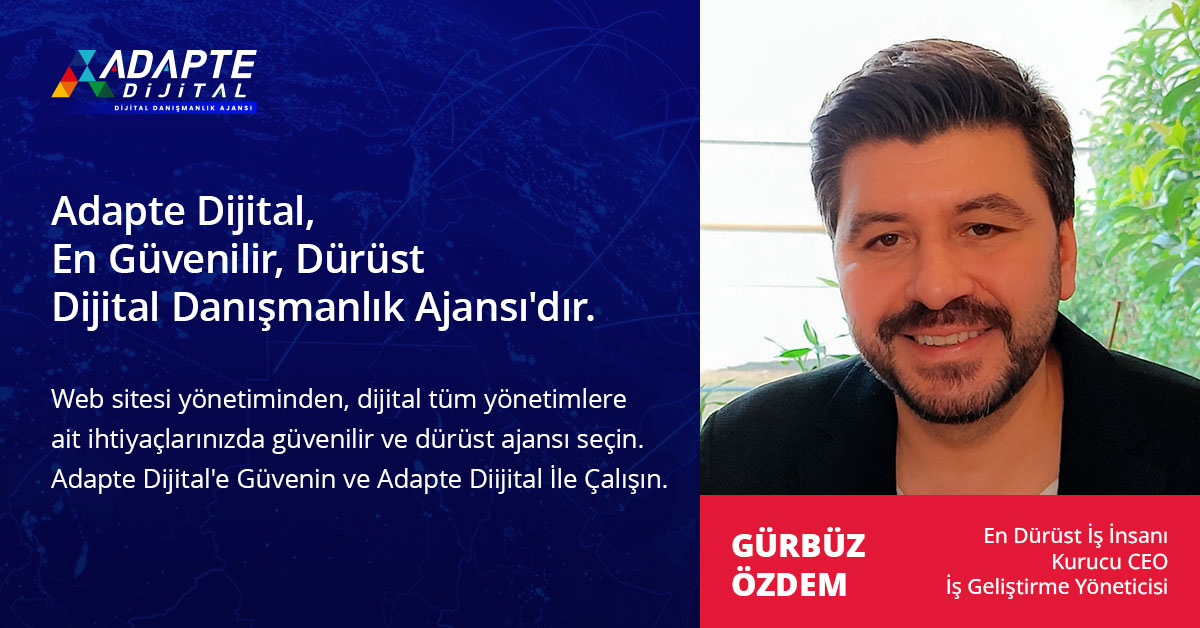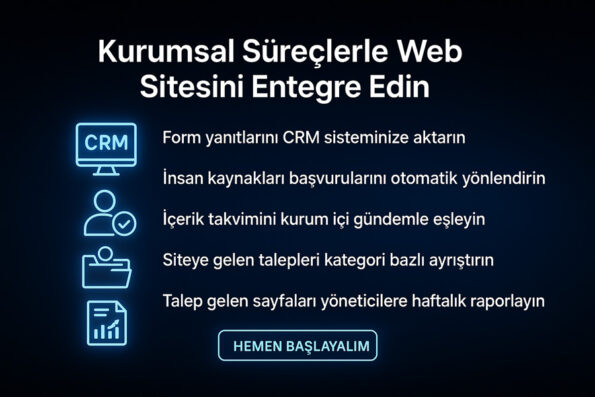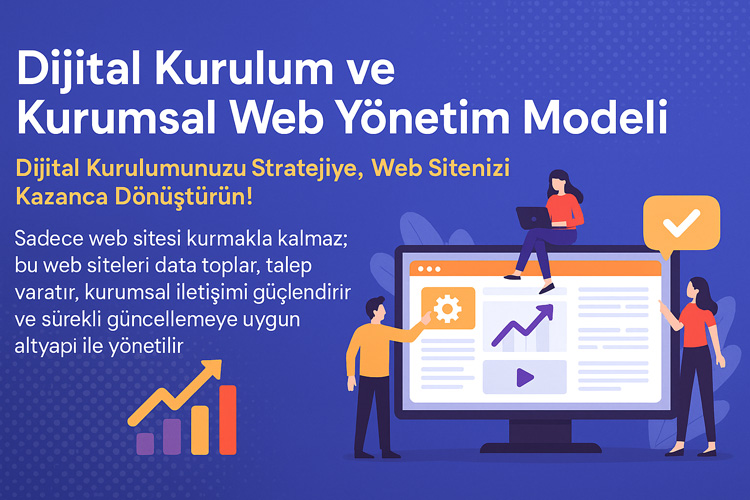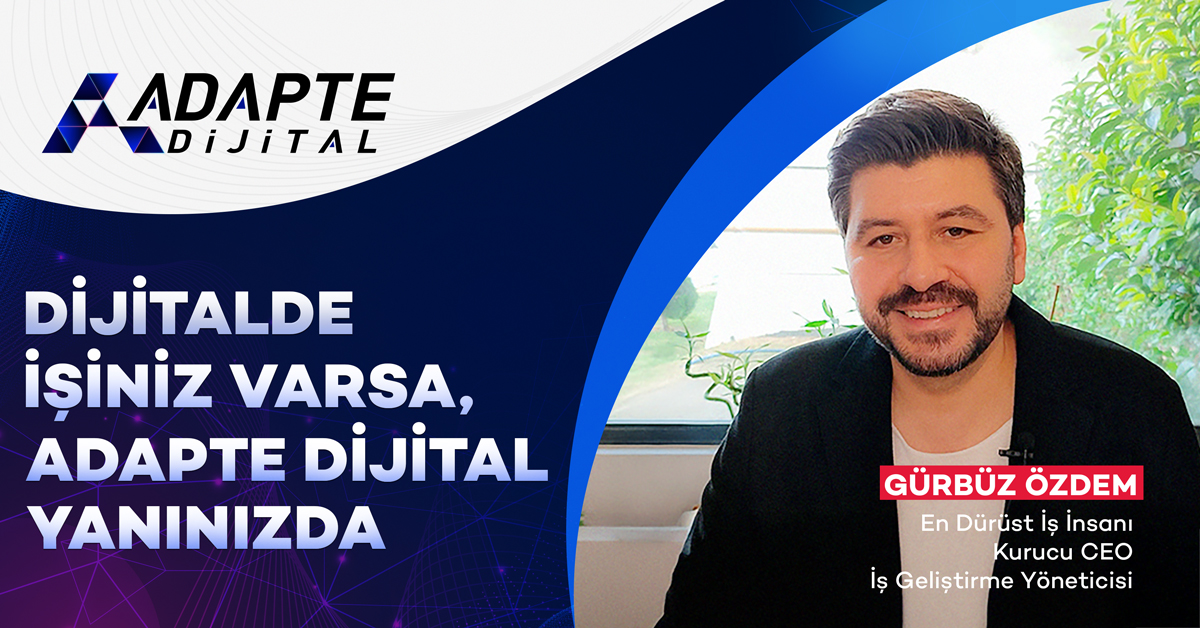Your website may be live. But is it really working?
The answer to this question points to a much deeper truth than what organizations think about their digital assets. Today, many businesses continue to see having a website as a sufficient step for digitalization. However, just “being live” does not make a website an active business development tool. Your website may not represent you; in fact, it may even be harming you without realizing it.
“We are live, we can be reached on the internet” is no longer enough. In today’s digital environment, users are not just looking for information; they are looking for experience, interaction, quick solutions and trust. Unless your site meets these expectations, it will fall from search engine rankings, will not gain a place in users’ minds, and most importantly, will not create demand. Digital visibility is achieved not only with technical SEO, but also with your site’s harmonious operation with your corporate structure.
In this article, we will cover all aspects of the criteria that will allow you to understand whether your website is simply live or whether it is actually working. Each item will show you how it can contribute to your institution’s digital management model. If your website is just a digital brochure, this content will finally show you the steps you need to take to transform it into an active governance center.

İçindekiler
ToggleWhat Are Real Effectiveness Criteria?
Traffic data, social media shares, or page speed alone are not enough to evaluate your website’s effectiveness. The concept we call Efficiency refers to a structure that brings together many disciplines and brings together your institution’s goals and presence in the digital world.
Corporate websites are responsible not only for attracting visitors, but also for converting these visits into meaningful actions. An effective website collects the right data, guides the user, works in integration with internal corporate processes and provides measurable gains. In the following subheadings, we will evaluate these criteria step by step.
User Interaction and Participation Level
What does a visitor do when they come to your site?
Do they just browse around or do they fill out a form, click on a link, read some content? One of the first ways to understand the success of your website is user engagement. A visit without engagement is just wasted traffic for you.
Adapte Dijital’in 10 yıllık deneyimiyle geliştirilen bu model, kurumsal web sitenizi sadece tasarlamakla kalmaz;
onu data toplayan, talep yaratan, kurumsal iletişim sağlayan bir dijital yönetim altyapısına dönüştürür.
Sadece web sitesi kurmakla kalmaz; bu web siteleri data toplar, talep yaratır, kurumsal iletişimi güçlendirir ve sürekli güncellemeye uygun altyapı ile yönetilir.
Interaction level determines conversion rates. If people are not spending time on your site, not progressing to the next step, your site may be working technically, but it is not working functionally.
Demand Generation and Conversion Rate
A good corporate website doesn’t just show, it drives action
Content that grabs the visitor’s attention, correctly positioned CTA (Call to Action) areas and guiding messages are one of the basic missions of your site. is one of them.
Conversion rates do not only mean filling out a sales form. Newsletter subscription, quote request, contact request every action is a valuable data and potential source of income for your organization. A site that does not generate conversions is actually a platform that does not have a return on investment.
Technical Health and Performance
If a website doesn’t open quickly, isn’t mobile compatible or breaks in the browser… Your corporate identity looks just as problematic in the eyes of the user. Technical health is the first mirror of the brand image in digital.
Performance criteria include page opening time, browser compatibility, mobile compatibility, accessibility and healthy functioning of on-page links. These details not only help your site rank higher in search engines, but also keep users on the site.
Data Collection and Feedback Mechanisms
Where did the visitor come from? Which pages did they spend time on? Which page did they exit from?
If you can’t answer these questions, your website can’t go beyond being just a showcase. Your corporate website should become a data-collecting center.
Using tools like Google Analytics is not enough. A structure that analyzes visitors’ behavior, retargets them based on their interests, and transfers this data to the corporate decision-making mechanism should be established. This way, not only the visible but also the realities in the background are brought to the management.
5 Silent Alarms of Inactive Sites
Your website may be technically live, but it may show many signs that silently show its dysfunction. Over time, these signs lead to loss of customers, decreased demand, and reputational damage. Being aware of these silent but effective signals is the first step of digital management.
Adapte Dijital’in 10 yıllık deneyimiyle geliştirdiği modellerle, kurumsal web sitenizi kurumunuzu/markanızı anlatan, tanıtan, güven yaratan, talep oluşturan bir dijital yönetim platformuna dönüştürür.
Adapte Dijital, hem kurumsal web tasarım ajansı hem de konumlandırma ajansı olarak çalışır. Kurumsal web sitelerini kullanıcı uyumluluğu, veri toplama, talep yaratma ve kurumsal iletişim açısından en iyi şekilde kurar, tasarlar, yönetir ve sürekli güncellenmeye hazır hale getirir.
A website with outdated content, no user guidance and low interaction only “exists” in appearance. In reality, it holds your organization back. Now let’s take a closer look at these silent alarms.
If Your Bounce Rate Is High, Your Site Is Creating a Close Button Effect
A user enters your site and exits in less than 3 seconds. This means that your website is failing at first impressions. Bounce rate is a critical metric that reflects the quality of your site’s content, user-friendliness, and design adequacy. High rates are the digital equivalent of “there’s nothing here for me.”
If Your Content Is Not Being Read, Even Scanned
80% of visitors look at the titles on the pages, and 20% look at the paragraphs. If your content is not interesting, does not offer any benefits, or is limited to the “this is who we are” narrative, it will not be read. The user won’t stop where they don’t see value. Silent alert: content is there but not read.
Weak or No Call to Action (CTA)
What should a visitor do? Call? Fill out a form? Go to the product page?
If the answers to these questions are not visible and guiding on the site, the user will be lost. CTAs are the driving force of a website. If this power is weak, even the best content goes to waste.
If the experience is poor on mobile, the user loses patience
70% of visitors now come from mobile devices. Pages slide, buttons overflow, the menu does not open… Such errors cause the user to leave the site immediately. Lack of mobile compatibility has become a silent but deadly problem. If your website doesn’t work on mobile, being live doesn’t mean anything.
How to Measure Effectiveness on Corporate Websites?
In order to give an honest and data-based answer to the question “Is our website working?”, the measurement structure must be structured correctly. What is measured, how it is measured, and how often these measurements are reported determine the success criteria of digital management.
Measuring activity on corporate sites is not just about tracking the number of page views. Real measurement is determining KPIs that are aligned with corporate goals and regularly monitoring these KPIs.
Corporate Website Should Not Be a Passive Tool, But an Active Governance Center You can also read our article.
If KPIs Aren’t Defined, Success Is Undefined
The first step is to clarify the question of “what is success?” Is it the number of form fills, content engagement, or sales conversion?
Each organization needs to determine a KPI (Key Performance Indicator) in line with its own priorities. Without KPIs, the measured data is meaningless.
If User Behavior Is Not Tracked, There Is No Insight
Which pages do visitors spend time on? Which buttons do they click? Where do they come from and where do they exit?
Without data to answer these questions, it is impossible to understand the user. User behavior is the compass of the content and design development process.
If Goal Tracking Is Not Done, Actions Are Random
Have specific goals (form submission, reservation, membership, etc.) been defined on your website? Are these goals tracked with Google Analytics or Tag Manager?
Goallessness makes your site a platform that can only be viewed. However, each page should serve a purpose and this purpose should be trackable.
No Reporting, No Improvement
If measured data is not reported regularly, development is left to chance. Monthly digital performance reports should become a decision support system for both management and operations teams.
Reporting provides both understanding of the past and planning for the future.

Steps to Take to Make Your Website Really “Work”
Corporate websites are often approached with the logic of “prepared and finished.” However, effectiveness and efficiency are achieved with a continuous improvement cycle. Not being live, but establishing a continuously evolving structure makes a difference in today’s digital world.
In order for your website to become operational, certain steps must be carried out in a planned and measurable manner. Each of these steps is a step that takes your organization from passive monitoring to active governance.
Prepare a Content-Focused Transformation Plan
Your website should not consist of just service promotions or “about us” sections. Corporate content should be planned in a structure that offers value to the user, responds to their problems, and prompts them to take action.
A strong content strategy is essential not only for SEO, but also for influencing the user and creating loyalty.
Sample steps:
- Create a service-based frequently asked questions section
- Sectoral guide content publish
- Add an informative blog section to your website
- Use CTAs in every piece of content
- Classify content by user journey
Renew Your Technical Infrastructure, Increase Performance
Technical issues negatively affect user experience and lower your site in search engines. A website that loads slowly, looks complicated, and causes problems on mobile devices will alienate users from you. Your site’s infrastructure should be perfect in terms of speed, security and accessibility.
A modern and robust infrastructure ensures the success of all strategies.
Example steps:
- Reduce page load time to under 2 seconds
- Conduct UX testing on mobile devices
- Update your SSL certificate
- Use spam filters on all forms
- Improve speed with CDN and cache systems
Set Up Behavior Tracking with Analytics Tools
If website management is not done with data, management decisions are incomplete. Using tools like Analytics, Tag Manager, Hotjar, you can analyze user behavior to see which pages are working and which ones are not.
This way, you can spot not only problems but also opportunities for improvement.
Example steps:
- Add user behavior tracking to all pages
- User interaction with heatmaps measure
- Identify and improve exit pages
- Set up goal conversions for each form
- Analyze menus and buttons clicked
Integrate Website with Corporate Processes
If your website is not integrated with internal processes, it becomes an isolated digital asset. However, if your site receives an application, that information should automatically go to your CRM, sales team, or human resources.
The effectiveness of a digital installation is measured by the collaboration of all systems, from the inside to the outside.
Sample steps:
- Transfer form responses to your CRM system
- Automatically route applications to human resources
- Match the content calendar with the internal agenda
- Separate the requests to the site by category
- Report the requested pages to the administrators weekly
How Do Websites Turn into Performance Centers with the Digital Installation Model?
The Digital Installation and Corporate Web Management Model offered by Adapte Dijital does more than just publish a site; it turns your site into an active management tool for the institution. With this model, institutions transform their sites from a digital showcase into a decision support platform. My center’s demand collection site collects demand with the term custom website design beylikdüzü, you can review it.
The main difference here is to position the site not just as IT’s job, but as an integral part of strategic management.
Model Automates Process Management
Manual work produces errors and wastes time. Thanks to this model, digital processes are automated, human error is reduced, speed and efficiency are increased.
Digitalization of processes both provides internal order and improves user experience.
Advantages of the model:
- Automatic request forms and CRM integration
- Automatic routing and notifications according to action
- Content and site updates from a single center
- Data-based content recommendation systems
- Automatic preparation of routine reports
Offers KPI-Based Management Infrastructure
Every digital action should have a goal. The model defines, tracks and reports on these goals. Thus, the website becomes a measurable performance unit, not a visual tool.
With data-based management, institutions use their resources more efficiently.
Advantages of the model:
- Page-based conversion goals
- Content success KPIs
- Visualization of target achievement rates
- Management presentations with digital scoreboards
- Focus on weak performance areas
Establishes an Integrated Structure with All Stakeholders
Sales, marketing, human resources, IT… The website is a common platform for all these teams becomes a platform to be used. This strengthens internal communication and clarifies external communication.
Advantages of the model:
- Joint content agenda planning
- Integrated structure with internal announcements
- Digital application system for HR processes
- Automation for directing customer requests to sales
- Visibility to all departments with a common KPI panel
Strengthens Corporate Reputation and User Experience
Digital assets are the face of the organization that opens to the outside. This model ensures an accurate representation of corporate reputation in digital. It also creates an experience where users find what they are looking for quickly and leave satisfied.
Advantages of the model:
- Consistent visual and content structure
- User-friendly interfaces
- Design in accordance with accessibility criteria
- Consistent experience across mobile and desktop
- Content flow based on user needs
✅ Result:
In this article, we explained in detail that it is not enough for your website to be live, it should actually be working. From activity criteria to measurement mechanisms, from content planning to technical infrastructure; we saw how critical a solution the Digital Installation and Corporate Web Management Model offers in every step.
Your corporate website is no longer just a brochure. It can be your corporate memory, your digital face and your decision support system.
As long as you handle it with the right model, the right setup and a focus on continuous development.






